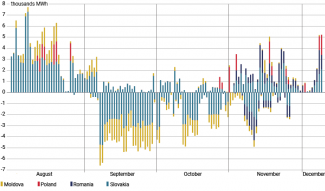Ukraine: the electricity system is readying itself for Russian attacks
On 7 December, Prime Minister Denys Shmyhal appealed to the Ukrainian public and business representatives to reduce electricity consumption as much as possible and to consider changing the operating hours of businesses due to the recurring electricity shortages. The shortages are happening amidst Ukraine’s intensive preparations for the upcoming waves of massive shelling of its energy infrastructure by Russia, which are expected with the onset of severe cold weather. Ukraine’s actions include building physical shields to protect power infrastructure and strengthening anti-missile and anti-drone defences for key facilities. In addition, Ukraine has been granted approval by the regional ENTSO-E group to increase network capacity with its neighbours, which will allow for an increase in imports to cover the shortages.
Waiting for the next strikes
Throughout the summer and first months of autumn, the Ukrainian government and companies from the electricity sector were working hard to remove the effects of attacks on the energy infrastructure during the previous heating season and carrying out planned renovations at both conventional and nuclear power plants. On 20 November, the renovation of the last of the nine nuclear reactors under Kyiv’s control was completed, and all units of this type (Khmelnytskyi, Rivne and South Ukrainian) have been operating at full capacity since that time. However, the situation is far from stable: one day later, five thermal power plants were shut down due to the need for emergency renovation, and a similar situation occurred on 4 December. Since power shortages recently happen quite regularly (every few days), the Ukrainian network operator Ukrenergo has been forced to seek emergency assistance from the neighbouring countries (usually Poland, Slovakia and Romania), and has reiterated its appeals to the public to limit the use of energy-intensive home appliances in the afternoon and evening peak consumption hours.
Along with the renovation works, all key players in the sector – Energoatom (the operator of nuclear power plants), DTEK (it accounts for around 75% of the output generated by Ukraine’s thermal power plants), Centrenergo (in charge of running state-owned conventional power plants), Ukrhydroenergo (operator of hydropower plants) and Ukrenergo – are preparing for the Russian attacks. The State Agency for Reconstruction and Development of Infrastructure has also been involved in the process: it was tasked with building a protection system for tens of distribution stations. Three levels of facility protection are envisaged as part of the system. The first level are gabions and sandbags to protect the units from fragments of rockets and drones. The second are concrete structures protecting against direct drone attacks. As part of the third phase, missile defence will be used to protect the 22 most important stations.
According to media reports, nuclear power plants, hydropower plants and the DTEK infrastructure are best prepared to defend against possible strikes. The situation is reportedly worse in Ukrenergo, due to the large number of facilities that require protection (high-voltage distribution stations throughout the country) and delays in concluding contracts for security works with subcontractors. Another problem is the insufficient number of spare transformers, given their limited availability on the market. The state-owned entity Centrenergo is probably worst prepared due to the numerous management staff overhauls it has seen in recent months. In all cases, it is difficult to assess how advanced the construction work is as detailed information has been kept secret for security reasons. Analysis of orders available in the Prozorro public procurement system shows that most contracts provide for completion of work in December 2023 or January 2024. In addition to physical protection, key electricity generation and transmission facilities (according to Ukrenergo and Energoatom’s declarations) are covered by anti-missile defence systems and anti-aircraft weapons, as well as electronic warfare means in cooperation with the army and the National Guard.
Foreign financial support plays an important role in the preparations. On 16 November, the United States announced that it had so far granted Ukraine $520 million in aid for the energy sector, and a further $500 million was to be provided in the near future. Some of these funds will be allocated for the purchase of transformers and other equipment damaged as a result of Russian attacks. In October, Ukrenergo also received a grant of €76 million from the German government, intended to finance transmission network protection systems and the construction of new high-voltage lines. Previously, Ukrenergo received over €220 million from Germany in the form of grants and loans to carry out the renovations of distribution stations, and German operators (Amprion, TenneT, TrasnetBW and 50 Hertz) donated over 100 devices necessary to carry out repairs. In addition, the Ukraine Energy Support Fund has been established within the Energy Community to meet the most urgent Ukrainian needs related to repairs and purchases of equipment. As of 7 December, it had €194 million at its disposal.
Wartime system operation
For security reasons, the Ukrainian government stopped publishing even general information on the structure and volume of electricity production since October 2022. However, data from DTEK show that the average daily consumption at the end of November was approximately 14 GW and was over 30% higher than during the same period last year, when Russian attacks on critical infrastructure were already underway. About 60% of energy is generated by nuclear power plants, another 20–25% by thermal power plants, 8% each by hydropower plants and combined heat and power facilities (CHP), and about 4% by renewable energy sources (RES).
Chart 1. Electricity generation as of 26 November 2023

Source: DTEK.
Deepened integration with neighbouring countries is vital for the system’s stability. This process began on 16 March 2022, when the electricity grid operators of continental European countries, associated in ENTSO-E, agreed to start the emergency synchronisation of the European grid with the Ukrainian and Moldovan grids. On 28 November this year, the ENTSO-E regional group concluded that Ukrenergo had met the main technical conditions for network synchronisation and agreed to increase the maximum capacity for electricity imports to 1,700 MW.
In the summer, when the renovation of some power plants coincided with high electricity consumption, Ukraine imported significant volumes of electricity, mainly from Slovakia, Moldova and occasionally from Poland (see Chart 2). At the beginning of September, as the renovations were close to being completed and the seasonal consumption had decreased, Kyiv began exporting energy on a larger scale, but limited it to night hours, when there was minimal demand on the domestic market. Even then, imports were often necessary in the afternoon and evening, during peak hours. Ukraine has been forced to import increasing amounts of energy since the beginning of November due to the drop in temperatures. Since 27 November, exports have been completely suspended, which most likely means that Ukraine does not have surpluses even at night. In the coming weeks, as consumption increases, a significant increase in electricity imports may be expected. The government is determined to prevent even the planned power outages for consumers that were seen during the last heating season.
Chart 2. Ukraine’s daily exports (-) and imports (+) of electricity

Source: ENTSO-E.
The public mood regarding problems with electricity supplies is moderately optimistic. According to a survey conducted on 1 December by the Rating group, 41% of respondents expect the situation to be better than last year, and 49% expect it to be the same. Three in four respondents consider themselves prepared for power outages because they have purchased flashlights, batteries and generators, and have stocked up on food and drinking water. The vast majority (74%) do not intend to leave their homes, even if the blackout lasts for a week. Of those who plan to leave, only 2% intend to go abroad.
Outlook
Contrary to the forecasts presented by the Ukrainian military intelligence, mass attacks on energy infrastructure have not yet started, unlike last autumn and winter. It seems that they will begin when there is severe cold weather, which will automatically result in maximum load on the grid. Currently, individual units are being shelled regularly, especially near the front. Although, as last season, a schedule of interruptions in supplies to consumers has been prepared, the Ministry of Energy of Ukraine declares that, if there is no large-scale damage to the infrastructure, no power outages for individual consumers should be expected, and any deficit will be covered by imports from the EU.
The fact that Ukraine has been repeatedly in need of emergency assistance from neighbouring countries also proves that the situation in the system is already strained. It is not known how effective the prepared protective fortifications and anti-drone and anti-missile defence will prove; and this question is difficult to answer. It is also an open question whether the nuclear power plants will come under attack. They are the main electricity production source, and the Russians have so far avoided attacking them. If even one nuclear power plant is disabled, the system will have very serious problems, and if all three cease operation, this will result in a blackout throughout the entire country.





